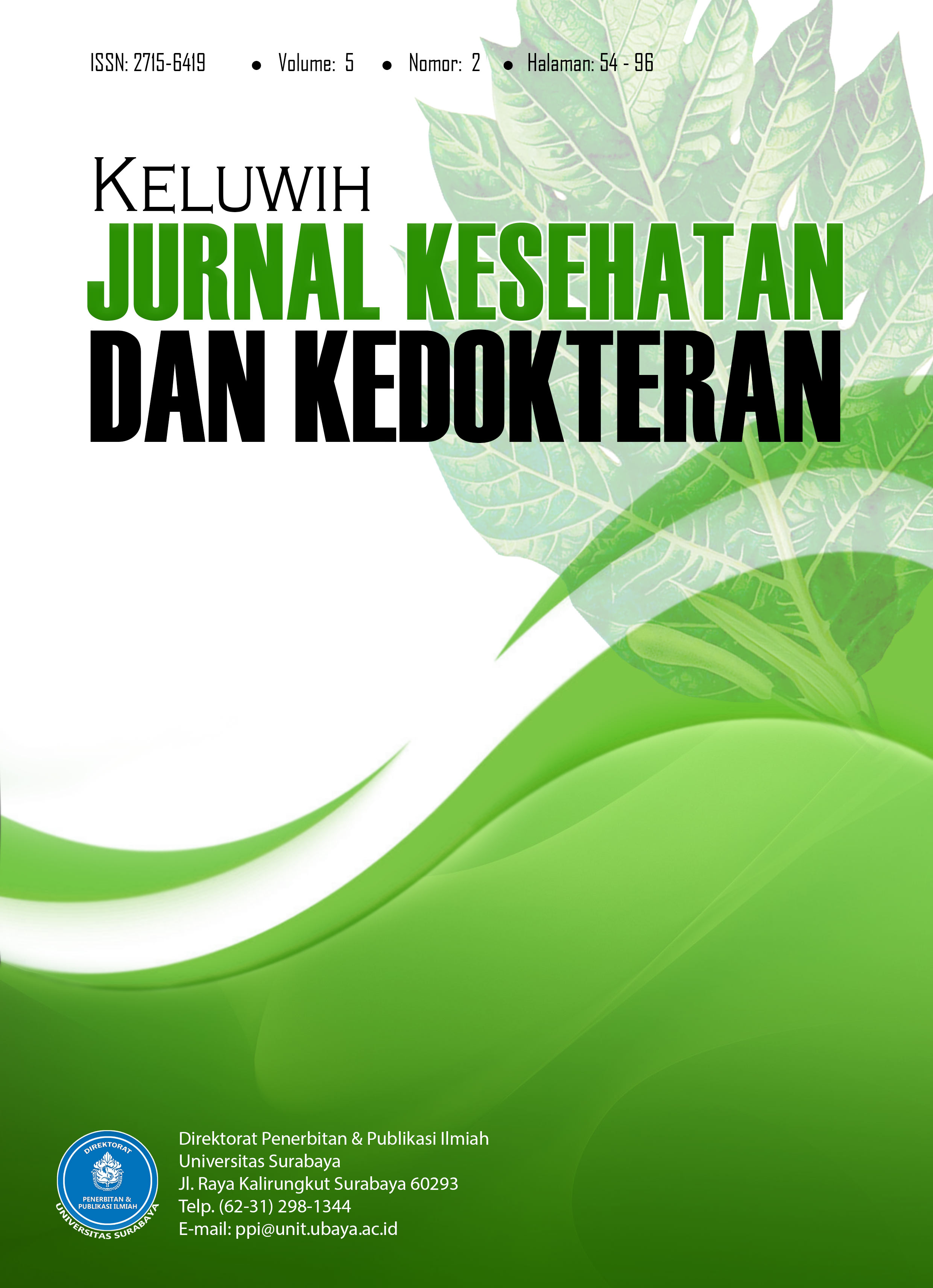Adakah Hubungan antara Usia dan Gangguan Indera Perasa pada Pasien COVID-19?
 Abstract Views:
510 times
Abstract Views:
510 times
 PDF Downloads:
377 times
PDF Downloads:
377 times
Abstract
Abstract—COVID-19 (coronavirus disease 2019) is a respiratory disease caused by severe acute respiratory syndrome coronavirus 2 (SARS-CoV-2). The clinical symptoms of COVID-19 patients vary widely, for example the olfactory and taste disorder. Several studies reported the prevalence of taste disorder of 71% to 88.8% in COVID-19 patient. This research aimed to determine the association between age and taste disorders during the spread of the Delta variant of COVID-19. A cross sectional study conducted on 42 subjects. The data was analyzed using Independent T-test. Statistical analyzed showed that 27 out of 42 subjects experienced taste disorders. The mean age of COVID-19 patients with taste disorders was 50 years (SD 12.83). In the independent T-test, a p-value of 0.613 was obtained (p>0.05), which means that there was no association between age and taste disorders. Taste disorders are caused by hyposalivation which begins to occur at the age of 65 and over. This study concluded no significant correlation between age and taste disorders in COVID-19 patients.
Keywords: COVID-19 patients, age, taste disorders
Abstrak—COVID-19 (coronavirus disease 2019) adalah penyakit pernapasan yang disebabkan oleh Severe Acute Respiratory Syndrome Coronavirus 2 (SARS-CoV-2). Gejala klinis pasien COVID-19 sangat bervariasi, di antaranya gangguan indera penghidu dan perasa. Beberapa penelitian melaporkan prevalensi gangguan indera perasa sebesar 71% hingga 88,8% pada pasien COVID-19. Penelitian ini bertujuan untuk mengetahui hubungan rerata usia dengan gangguan indera perasa selama penyebaran COVID-19 varian Delta. Studi cross sectional dilakukan pada 42 subjek penelitian. Teknik pengambilan data adalah total sampling, yaitu pada pasien yang rawat inap karena COVID-19. Data dianalisis dengan menggunakan Uji T-tidak berpasangan. Analisis statistik menunjukkan bahwa 27 dari 42 pasien mengalami gangguan indera perasa. Usia rata-rata pasien COVID-19 dengan gangguan indera perasa adalah 50 tahun (SD 12,83). Pada uji T-tidak berpasangan didapatkan nilai p sebesar 0,613 (p>0,05), yang berarti tidak ada hubungan antara usia dengan gangguan indera perasa.
Kata kunci: pasien COVID-19, usia, gangguan perasa
Downloads
References
Singhal T. A Review of Coronavirus Disease-2019 (COVID-19). The Indian Journal of Pediatrics 2020 Apr. 87(4):281–286.
Liu N, Yang D, Zhang T, et al. Systematic review and meta-analysis of olfactory and gustatory dysfunction in COVID-19. International Journal of Infectious Diseases. 2022. 117:155–161.
Aziz M, Perisetti A, Lee-Smith WM, et al. Taste Changes (Dysgeusia) in COVID-19: A Systematic Review and Meta-analysis. Gastroenterology. 2020 Sep. 159(3):1132–1133. Av
Carrillo-Larco RM, Altez-Fernandez C. Anosmia and dysgeusia in COVID-19: A systematic review. Wellcome Open Res. 2020 May. 5:94. Available from: https://wellcomeopenresearch.org/articles/5-94/v1
Mahmoud MM, Abuohashish HM, Khairy DA, et al. Pathogenesis of dysgeusia in COVID-19 patients: a scoping review. European review for medical and pharmacological sciences. 2021. 25(2):1114–1134.
Ahn EJ, Min HJ. Prevalence of Olfactory or Gustatory Dysfunction in COVID-19 Patients: An Analysis Based on Korean Nationwide Claims Data. Clin Exp Otorhinolaryngol. 2021 Nov. 14(4):427-430.
Toan NK, Ahn SG. Aging-related metabolic dysfunction in the salivary gland: A review of the literature. International Journal of Molecular Sciences. 2021 May. 22(11):5835.
Braun T, Doerr JM, Peters L, et al. Age-related changes in oral sensitivity, taste and smell. Scientific reports. 2022. 12(1):1533. Available from: https://pubmed.ncbi.nlm.nih.gov/35087097/
Li L, Wang H, Hu L, et al. Age associated decrease of sialin in salivary glands. Biotechnic & Histochemistry. 2018. 93(7):505-511.
Pedrosa MS, Sipert CR, Nogueira FN. Salivary glands, saliva and oral findings in COVID-19 infection. Pesqui Bras Odontopediatria Clin Integr. 2020. 20 (Suppl 1):1–7.
Kusnik A, Weiss C, Neubauer M, et al. Presence of gustatory and olfactory dysfunction in the time of the COVID-19 pandemic. BMC Infect Dis. 2021 Dec. 21(1):612.
Farshidfar N, Hamedani S. Hyposalivation as a potential risk for SARS-CoV-2 infection: Inhibitory role of saliva. Oral Dis. 2021 Apr. 27 (Suppl 3):750–751.
Diep MT, Jensen JL, Skudutyte-Rysstad R, et al. Xerostomia and hyposalivation among a 65‐yr‐old population living in Oslo, Norway. Eur J Oral Sci. 2021 Feb. 129(1):e12757.

This work is licensed under a Creative Commons Attribution-ShareAlike 4.0 International License.
- Articles published in Keluwih: JKK are licensed under a Creative Commons Attribution-ShareAlike 4.0 International license. You are free to copy, transform, or redistribute articles for any lawful purpose in any medium, provided you give appropriate credit to the original author(s) and the journal, link to the license, indicate if changes were made, and redistribute any derivative work under the same license.
- Copyright on articles is retained by the respective author(s), without restrictions. A non-exclusive license is granted to Kluwih: JKK to publish the article and identify itself as its original publisher, along with the commercial right to include the article in a hardcopy issue for sale to libraries and individuals.
- By publishing in Keluwih: JKK, authors grant any third party the right to use their article to the extent provided by the Creative Commons Attribution-ShareAlike 4.0 International license.

 DOI:
DOI:






